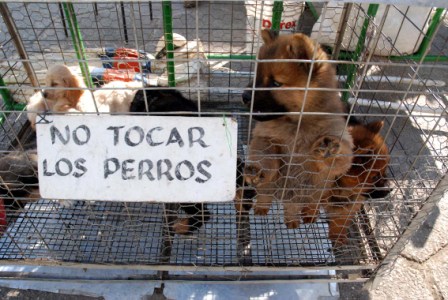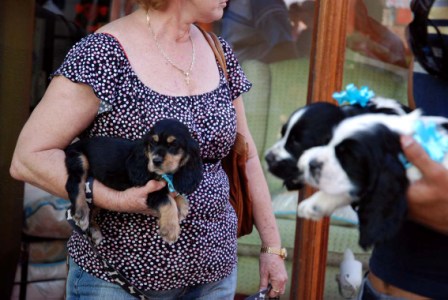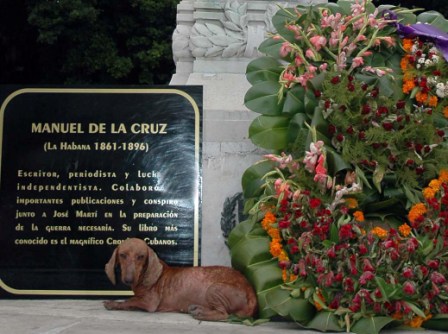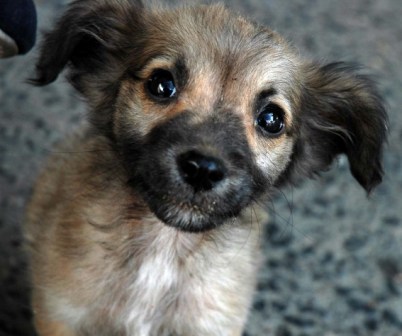Havana & Its Dogs
By Jose Antonio Michelena, Photos: Caridad

HAVANA TIMES, Sept. 10 (IPS) – Among people traveling along 23rd Street in the capital’s Vedado district – teeming with people around 11:00 in the morning in front of the Chaplin Cinema – a man pedaling by on his bicycle was just one person more. But the act he committed made his presence loom large.
Tied to the frame of his bike he had a rope, and tied to that rope a dog – with its paws firmly trying to dig into the asphalt as it was dragged down the street.
The eyes of the animal reflected the pain of the torture it was being subjected to. Yet no one said anything. No one stopped the executioner. And who knows how much longer the dog had to continue suffering.
Several days have now gone by, but I cannot erase that scene from my mind. It was not one of those now everyday scenes – equally condemnable – of training for back-alley fights between pit bulls, mastiffs and other breeds; this was just one (other) demonstration of street torture that transforms us into accomplices.
The torturer not only degrades his human condition, but ours as well. We are all dragged along by that rope.
Lives of Havana Dogs Vary Considerably
Nowadays, you see more and more dogs in Havana – almost all breeds: German shepherds, boxers, Chihuahuas, Pekinese, cocker spaniels, Afghans, Siberian huskies, “wieners,” Dalmatians, Chow Chows, Dobermans, bull mastiffs, beagles, Rottweilers, Stanfords, poodles, and local breeds- dogs of all sizes and colors.

Likewise, these range from domestic dogs, guard dogs, work dogs, fighting dogs, street dogs and family pets; dogs that seem happy and dogs that live well, or dogs that struggle to survive; very well treated dogs, and those not so well treated.
The lives of dogs in the city are not all the same. It depends on the circumstances in which they come into the world. And it depends – especially – on the owner, if they have one.
Raquel, 88, is a widow who admits that her toy poodle is encouragement to continue living. In the home of Mara there’s also a dog, because when her children were little they asked for one. Now that the boys don’t live with her, Yoni is a nuisance, but he’s still very well treated.
Mara is a good person, though even better is the luck of Napoleon: a 12 year-old Pekinese that reigns as emperor in Matilde’s home. In past periods of Cuban hard times, his owner even gave up her chicken ration for the pet.
On the flip side, Sandra’s dogs are always hungry; they live in the stairways of the building and do their “necessities” where they please. One of them has bitten several people.

The stories pet owners tell are quite varied, as are their reasons for owning dogs, cats, turtles or parrots. Many of them are not aware of their responsibilities to the animals: that they should feed them, take care of them and protect their health. The irresponsibility of owners towards their dogs is a serious problem in Havana.
Negligence is causing difficulties in multi-family buildings and public spaces where those animals mix with strays at the risk of their very lives, because they can catch fatal diseases such as Zoonosis.
No Laws to Protect Animals
The absence of an animal protection law is taken advantage of by those people who thrive in the margins of legality. The rest of society suffers from the disorder, where animals above all are victims of acts of barbarisms like the one pointed to. Yet certainly, dogs are not the only victims.
In a practice generalized throughout all of the provinces, horses are forced to work without rest for many hours transporting exhausting loads.

Questioned in an interview with the Latin American and Caribbean Women’s News Service about the most frequent demonstrations of violence that he treats as a veterinarian, Dr. Angel Mario Rodriguez responded, “I can’t give an exact statistic, but we see a great deal of aggressiveness, fear and submissiveness.
“I could easily mention visible physical consequences, such as fractures, cuts, urinary incontinence, which stop them from breastfeeding their offspring prematurely, for example. On the other hand, species raised in confinement are exposed to fatal consequences, the product of neglect in their care, such as exposure to bad weather, starvation or overcrowding, which for me are also demonstrations of violence.
“In rural areas you still find those who castrate their animals employing archaic methods, like using a mallet without anesthesia. Imagine…farmers gloat when saying that an animal is well castrated only when they grind their teeth in absolute agony!

“Also, I’ve seen animals plowing in the full sun, without rest; and horses pulling wagons while the owner beats them with a whip to keep them working; and also accidents caused by unconstrained livestock on the highway. In the city you run into other variants such as abandonment, illegal genetic crossings and animals that are locked in little rooms for eight hours while waiting for their owners.
“I know of a case where a dog was locked on the balcony ten hours; when the owner came home, the dog – high strung with excitement – jumped from the third floor and he died,” said the vet.
In another segment of the interview, the vet noted, “Some researchers suggest that violent adults mistreated animals in their childhood. That may be true, but I believe that there are people who mistreat animals, men and women; and as victims of violence, they reproduce these acts of aggression upon the weakest. Violence is related to power…to control; and animals – given their dependence and defenselessness – are the perfect victims, similar to girls and boys – only that children are strictly protected by laws.”
Animal Abuse as a Business
“There are people who abuse animals as a business, as in the cases of dog fights and cock fights. These individuals were already cruel, and they pose even more danger to their peers and animals once introduced to these illegal activities.”

Another pending issue in Cuba is control – in a humane way – over the dog population, which is exercised here through sacrificing them. This severely criticized practice has been commented on in the media on several occasions. The newspaper Juventud Rebelde, in a report dated May 6, 2007 wrote, “Every day in the city of Havana, according to the Provincial Department of Public Health and Epidemiology, between 10 and 15 animals are captured running loose in the streets; the majority are dogs, and almost all of them wind up being put down – and this is only in one province.
“The figure of all those animals sacrificed annually across the country can be derived with a simple mathematical calculation – and it’s alarming.” The article goes on to point out, “The National Institute of Veterinary Medicine assures that the mass of dogs controlled in Cuba is considered to be more than 1.96 million, along with another half million cats. Similarly, the Public Health Department of the City of Havana affirms that one dog exists for every ten people in the capital, which means there must be more than 200,000 canines. Twenty percent of them, using current medical terminology, ‘should be cleaned up’ – in other words: they should be sacrificed.”
This statistic can be easily surpassed if we keep in mind that dogs give birth to from six to seven puppies every seven months. Sadly, a good part of them are destined to violent and premature deaths.
Since its creation in 1987, the Cuban Society for the Protection of Animals and Plants (Aniplant) has centered its work on educational and awareness work, and dog and zoonosis control.

Its president, Nora García, explains that they attend to two animal observation centers in the capital, pick up abandoned dogs and cats, carry out sterilization campaigns in poor neighborhoods to control the birth of unwanted animals, provide humanitarian education to children, assist with two radio programs and respond to the many invitations they receive.
However, they are especially active with several projects that are run out of the association’s central headquarters: a veterinary clinic with free services, animal “hair care,” a documentation center, a “zoo hotel,” a take-in service for animals in need of ongoing treatment for injuries or illnesses, and an animal adoption service.
Notwithstanding, the lack of resources impedes the progress of their projects. The association is very poor: it is maintained by meager membership fees and small donations. Yet its goal is very rich: to win the passage of an Animal Protection Act.
A Demand on Society
Although human beings and dogs have shared company for 14,000 years, people have still not learned how to understand dogs. On the other hand, dogs do indeed know how people smell, how they walk, how they speak; they can distinguish them between the multitude of human voices and noises – especially those of their owners.
Recently, a researcher from the University of British Columbia (Canada) stated that dogs can solve complex problems and understand up to 250 words. But humans? To what extent have people comprehended the loyalty, affection or devotion of dogs? And how much do they appreciate the rewards dogs give us with their love, until death separates them from us?
Click on the thumbnails to see all the photos in this gallery

























This developing subculture of fighting animals for monetary gain (and gangsta ‘prestige’) is yet one more example of capitalist barbarism making its way back into Cuba, thru the vector of poverty and general want in the population. It really can be seen as a social, psychological disease — like venereal ones. And since the only way of effectively dealing with it is socialist development — or any development, really, at such a low level — the cuban government is essentially stymied, in its political-economic isolation in a sea of capitalist political-economic depravity.
So the only REAL answer remains socialist revolution in the imperialist West — because it’s pretty clear that there are real, concrete, objective limits to the class solidarity and organization of an impoverished cuban people. And of course the Party and its apparatus cannot substitute itself for the laboring cuban masses. It cannot be done.
Anyone interested in helping Cuban animals is encouraged to visit our website: TheAniplantProject.org, and/or write to: [email protected]. Also, please visit our blog at: HelpingCubanAnimals.blogspot.com
POR FAVOR TENGO UN PERRO COQUI SPANER DE TRES AÑOS, QUIERO ENTREGARSELO A ALGUIEN RESPONSABLE, PUES NO TENGO TIEMPO PARA SU ATENCION. ESTA CUIDADO Y CON TODAS LAS VACUNAS REQUERIDAS. SI CONOCE DE ALGUIEN QUE LO DESEE, PÓNGAME EN CONTACTO CON EL INTERESADO.
SALUDOS,
fAUSTO
I accidentally came upon this website, and was totally horrified, I would hope that the people of Cuba, and in Havanna, etc., would stand up and not permit ANIMAL ABUSE, that is so cruel and inhumane, that I am totally repulsed, if there is anything I can do to sign, etc., please let ;me know….I am all for Animal Rights, and anyone who willingly hurts an animal will pay with a dear Karma, the wheels of the gods grind slowly, but they do grind away…………………Shame on that person who harmed that dog……let’s hope he gets his just reward………..let’s not let the michale vick’s of the world go unnoticed and unresponded to………………I am also appalled that not one person reacted to such horror, are the people of Cuba blind to such cruelty and harm to their animals…..is that the kind of society they live in????
Can you send me the address and telephone number of Aniplant.
Tank you very much.
Good and needed piece Jose Antonio. It is shameful the way so many Cuban revolutionaries, national patriots, communists, socialists and other Cubans mistreat animals. It has always astonished me. And to read that the Cuban revolutionary government after 50 years in power has not made mistreatment of animals a crime, and that it does next to nothing to protect animals is even more astonishing. How can a revolutionary, humane, internationalist government and society allow this to happen?
And you put it so well: “The torturer not only degrades his human condition, but ours as well. We are all dragged along by that rope.”
To be a revolutionary, to assert one’s very humanity, requires us to practice what we preach, to put into practice our ideological ethic: to stop this degradation and remove the rope from us all.